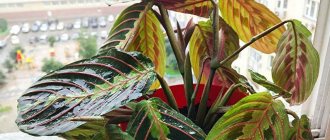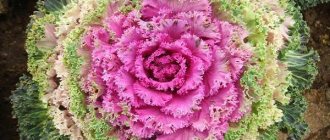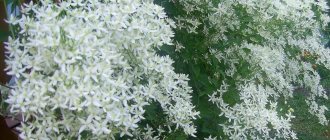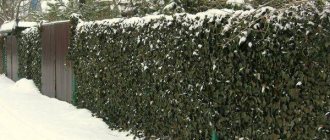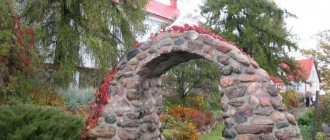The art of ornamental, curly cutting of plants has been known since the times of Ancient Egypt and Ancient Rome. In Russia, it developed during the time of Peter I, when the construction of palaces modeled on Versailles with regular parks around them began. Topiary haircut, in addition to favorably emphasizing the front part of the site, is also necessary when creating private areas for privacy - offices, bosquets, currently fashionable labyrinths, etc.
What to cut
To create topiary objects, as a rule, small-leaved plants are used: the larger the leaves and the sparser the crown, the more space the object or composition takes up. Accordingly, a curtain made of small-leaved linden with a crown trimmed in the shape of a cube, or berso made of small-leaved elm, are appropriate in parks, and in a small garden, plants such as cotoneaster, honeysuckle, Thunberg barberries, cinquefoil, common hawthorn, spirea, and golden currant are used , gray rose, etc.
Berso
There is a classification of plants suitable for topiary haircuts:
- for tapeworms with a molded crown (deciduous and coniferous);
- with a shaped crown (high, medium, low);
- for trimmed walls (scenes);
- for hedges (thorny and non-thorny, of various heights, deciduous and evergreen).
The listing of these plants will take more than one page, so in the framework of this article we will only note that boxwood, which is so popular in Europe, winters relatively stably in our country south of the Kaluga and Tula regions, therefore, the figures cut from it must be kept in containers and put away in the house for the winter, and creating borders or hedges from boxwood is very risky.
By the way, topiary forms in containers displayed at the entrance to the house or in the yard on stone paving will create a feeling of Mediterranean style on your site.
For Russia, as solitary topiary plantings, it is best to use coniferous plants that are consistently decorative all year round - western thuja or junipers (for example, Juniperus virginanum 'Skurosket'); for sculptural pruning, you can take the yew berry that winters here.
Dictionaries define the concept of “topiary” as the art of artistic pruning and giving decorative shapes to the crowns of trees and shrubs.
Features of topiary bush trimming
Curly pruning of bushes is not just a whim of gardeners who want to decorate their plot in an original way, but a real art, the roots of which go back to ancient times.
It is generally accepted that the art of topiary originated in Persia and Ancient Egypt, but its greatest flowering occurred in the 15th century. It was at this time that Louis the Fifteenth stood at the reins of power in France, who wanted Versailles to be decorated with hedges. This fashion quickly took root in all European gardens. Currently, topiary has not been forgotten; on the contrary, interest in it is experiencing a kind of fashion boom.
Nowadays, not only professionals and landscape designers are interested in the art of curly pruning of bushes, but also ordinary amateurs who want to create an individual style for their garden.

Fashion trends
Modern fashion trends in topiary haircuts offer several directions:
- solitaire figures of animals or hearts, made of yew, thuja and, naturally, boxwood;
- bonsai trimmings;
- haircuts in the form of umbrellas (from field maple or, for example, Canadian serviceberry);
- different shades of color spots (for example, yellow-leaved and red-leaved vesicle or deren - yellow and white variegated forms, as if penetrating each other);
- various figures created using frames, lawns, vines and even annuals (the time for producing the finished composition in this case is significantly reduced);
- trellis forms of various trees (wall, arched);
- trimmed hedges with rhythmic alternation of different colors (arborvitae with green and golden needles, yellow-leaved and purple barberries, etc.
Plants (usually on a trunk, but bush forms can also be used) with various graftings are becoming increasingly common. For example, the weeping form of a tree topped with a clipped “ball”, or foliage of different shades on one plant. You can buy ready-made arches from trees, tie specially curved and trimmed tops together and get not only an arch, but also a living gazebo.
Trimming shrubs and trees: decoration methods and cutting tools
The art of artistic trimming of bushes and trees is called topiary. The roots of this skill go back to the ancient world, but this technique gained popularity in the mid-15th century. Nowadays, not only landscape design professionals dream of mastering the techniques of this work. Ordinary amateur gardeners also try themselves in this matter. I became interested in topiary of bushes and trees when I saw how well-groomed and original a garden with green statues became.

Site selection and care
Trees or shrubs intended for topiary cutting must be planted in a well-lit place to avoid uneven foliage and internal rotting. The soil should be drained, fertile, but not oversaturated with nitrogen.
watered and fertilized according to their purpose (it is incorrect to use fertilizers intended for ornamental shrubs for conifers). Particular care must be taken to monitor the condition of the soil in containers.
trimming should be carried out regularly (but not before winter - so that the plant calmly prepares for hibernation and does not waste energy on additional growth) using garden shears or hedge trimmers (we are talking mainly about trimmed hedges, when a large number of branches are cut and the direction shoot growth is no longer so important), and pruning is done using pruning shears. To compact the crown of the plant, a cut is made above the bud “looking” inward; each branch is cut separately (trellises, tapeworms, bonsai). The wounds are treated in a special way for the fastest healing of the cut.
Pruning should be done in spring. It is advisable to start cutting plants at the age of five (when the root system is already well formed) and not to cut more than one third of the green mass. When cutting, you can use ready-made templates to accurately maintain the originally created shape. The ideal shape for a clipped hedge is wide at the bottom and tapering at the top, so that the lower branches receive enough light.
Standard plants, due to their high windage, must be tied up or strengthened with guy wires until they are completely rooted.
In winter , trees and shrubs are tied with twine or covered with special frames to avoid breaking branches under the adhering snow. In the first year of planting, you can also shade conifers from sunburn.
This art requires significant costs both for the creation of figures, ornaments or hedges, and for the constant maintenance of garden design objects in the desired form. In any case, it is better to entrust the care of pruned plants to specialists, and then the original compositions conceived by the designer will decorate your garden for many years.
What plants to use
It would seem that what could be simpler - pruning a bush or tree? In reality, everything is not so easy. Firstly, it is worth considering that not every plant is suitable for pruning. You can learn how to make a garden labyrinth at your summer cottage.
The most common suitable ones are the following bushes for decorative pruning:
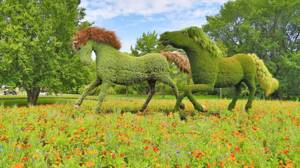
The first plant, despite its toxicity, is quite often used in garden compositions, requiring cutting twice a year. Yew requires similar care to boxwood and is also great for creating figurative statues. Holly is a thorny plant that can be used to create a real living fence. Cotoneaster is good for carving shapes, but it needs to be trimmed quite often for a neat and tidy appearance.
The ideal material for creating hedges is privet, which requires trimming only once a year in warm weather.

Haircut or trimming
It is necessary to distinguish between the concepts of “haircut” and “trimming”. When pruning, they deal with each branch individually, using pruning shears. There are rules regarding how to make a cut, which buds to stimulate, how to treat wounds, etc.
And pruning is also called blind pruning, when it doesn’t matter where exactly on the branches the cuts are made. The whole plant is simply trimmed to the established dimensions. In this case, you can no longer use pruning shears, because you need to cut a lot of branches.
The haircut is carried out using garden shears, petrol or electric hedge trimmers. Pruning is usually done in the spring, and shearing is done several times a season.
___________________________________________________
Garden bonsai - trees in miniature
Thai style bonsai formed from bougainvilleas
When you hear the word “bonsai”, the image of a tree in a pot, for example a pine or an oak, appears in your mind, which is an absolute copy of a real forest giant, only tiny in size.
Techniques and methods for trimming bushes
If you decide to start landscaping and creating an original landscape on your site, then you need to know the methods and techniques of trimming bushes.
- So, deciduous trees are pruned once a year in the spring, until the buds bloom. Due to last year's branches, they increase their volume by 5–10 cm.
- But plants used to create hedges need to be trimmed several times throughout the year. The first topiary trimming of the bushes must be done before the buds open, leaving 5 cm of growth from last year. The next haircut is made to the level of the first.
- If the fence is built using coniferous shrubs, then you should know that you cannot cut the bushes strictly vertically from the sides, since they should taper slightly towards the top. If this is not done, the lower part will very quickly be left without needles.
- Plants are trimmed from the bottom up. Also, do not forget that your figures and hedges consist of living plants, which means they need regular feeding with vitamins and water.
- In order for the crown of the plant to be lush and attract the eye with its density, it is recommended to prune young plants quite liberally. It is best to use a garden knife or pruning shears for this.
Beautiful decorative pruning of bushes can be carried out not only by specially trained professionals, but also by you personally in your own area. You just need to apply a little patience, attention and imagination. Heather lovers will find this material useful.



